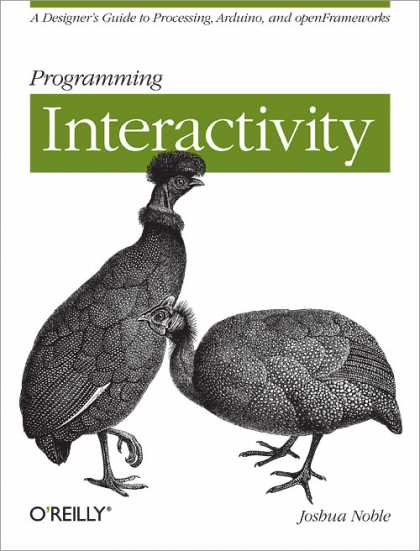Joshua Noble: Programming Interactivity: A Designer’s Guide to Processing, Arduino, and OpenFrameworks (2009)
Filed under manual | Tags: · arduino, human-computer interaction, interactivity, physical computing, processing

If you’re interested in using electronics and programming to create rich interactive experiences with your artwork, designs, or prototypes, “Programming Interactivity” is the place to start. You’ll explore common themes in interactive art and design, like 2D and 3D graphics, sound, physical interaction, computer vision, circuit bending, geo-location and more. This book explains programming and electrical engineering basics, and introduces three freely available tools created specifically for artists and designers:
- Processing, a Java-based programming language and environment for building projects on the desktop, Web, or mobile phones
- Arduino, a system that integrates a microcomputer prototyping board, IDE, and programming language for creating your own hardware and controls
- OpenFrameworks, a coding framework simplified for designers and artists, using the powerful C++ programming language
You’ll get working code samples you can use right away, along with the background and technical information you need to design, program, build, and troubleshoot your own projects. “Programming Interactivity” also examines cutting-edge design techniques, and includes discussions with leading artists and designers on projects and theory.
Publisher O’Reilly Media, Inc., 2009
ISBN 0596154143, 9780596154141
Length 768 pages
more info (gbooks)
programminginteractivity.com
preview
Paul D. Miller, aka DJ Spooky That Subliminal Kid: Rhythm Science (2004)
Filed under pamphlet | Tags: · code, language, memory, music, myth, networks, remix, sound recording, technology

“Once you get into the flow of things, you’re always haunted by the way that things could have turned out. This outcome, that conclusion. You get my drift. The uncertainty is what holds the story together, and that’s what I’m going to talk about.”
—Rhythm Science
The conceptual artist Paul Miller, also known as Dj Spooky that Subliminal Kid, delivers a manifesto for rhythm science—the creation of art from the flow of patterns in sound and culture, “the changing same.” Taking the Dj’s mix as template, he describes how the artist, navigating the innumerable ways to arrange the mix of cultural ideas and objects that bombard us, uses technology and art to create something new and expressive and endlessly variable. Technology provides the method and model; information on the web, like the elements of a mix, doesn’t stay in one place. And technology is the medium, bridging the artist’s consciousness and the outside world.
Miller constructed his Dj Spooky persona (“spooky” from the eerie sounds of hip-hop, techno, ambient, and the other music that he plays) as a conceptual art project, but then came to see it as the opportunity for “coding a generative syntax for new languages of creativity.” For example: “Start with the inspiration of George Herriman’s Krazy Kat comic strip. Make a track invoking his absurd landscapes… What do tons and tons of air pressure moving in the atmosphere sound like? Make music that acts a metaphor for that kind of immersion or density.” Or, for an online “remix” of two works by Marcel Duchamp: “I took a lot of his material written on music and flipped it into a DJ mix of his visual material—with him rhyming!”
Tracing the genealogy of rhythm science, Miller cites sources and influences as varied as Ralph Waldo Emerson (“all minds quote”), Grandmaster Flash, W. E. B Dubois, James Joyce, and Eminem. “The story unfolds while the fragments coalesce,” he writes.
Miller’s textual provocations are designed for maximum visual and tactile seduction by the international studio COMA (Cornelia Blatter and Marcel Hermans). They sustain the book’s motifs of recontextualizing and relayering, texts and images bleed through from page to page, creating what amount to 2.5 dimensional vectors. From its remarkable velvet flesh cover, to the die cut hole through the center of the book, which reveals the colored nub holding in place the included audio CD, Rhythm Science: Excerpts and Allegories from the Sub Rosa Archives, this pamphlet truly lives up to Editorial Director Peter Lunenfeld’s claim that the Mediawork Pamphlets are “theoretical fetish objects . . . ‘zines for grown-ups.”
Publisher MIT Press, 2004
A Mediawork pamphlet
ISBN 026263287X, 9780262632874
128 pages
Hypnotext (Rhythm Science’s webtake by Peter Halley)
publisher
publisher
google books
PDF (no OCR; updated on 2013-1-23)
Comment (0)Adrian Mackenzie: Cutting Code: Software and Sociality (2006)
Filed under book | Tags: · algorithm, bioinformatics, code, programming, sociology, software, software art, software studies

“Software has often been marginalized in accounts of digital cultures and network societies. Although software is everywhere, it is hard to say what it actually is. Cutting Code: Software and Sociality is one of the first books to treat software seriously as a full-blown cultural process, and as a subtly powerful material in contemporary communication. From deCSS to Java, from Linux to Extreme Programming, this book analyses software artworks, operating systems, commercial products, infrastructures and programming practices. It explores social forms, identities, materialities and power relations associated with software, and it asks how software provokes the re-thinking of production, consumption and distribution as entwined cultural processes. Cutting Code argues that analysis of code as a mosaic of algorithms, protocols, infrastructures, and programming conventions offers valuable insights into how contemporary social formations invent new kinds of personhood and new ways of acting.”
Publisher Peter Lang, 2006
ISBN 0820478237, 9780820478234
215 pages
Keywords and phrases
bioinformatics, Linux kernel, Java Virtual Machine, deCSS, extreme programming, JUnit, operating system, Sun Microsystems, CORBA, open-source software, software art, Java programming language, ontology, software development, unit tests, Linus Torvalds, RAMOSS, source code, Perl poetry, Unix philosophy
PDF (updated on 2019-12-16)
Comments (4)
